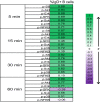Racial differences in B cell receptor signaling pathway activation
- PMID: 22672557
- PMCID: PMC3464787
- DOI: 10.1186/1479-5876-10-113
Racial differences in B cell receptor signaling pathway activation
Abstract
Background: Single-cell network profiling (SCNP) is a multi-parametric flow cytometry-based approach that simultaneously measures basal and modulated intracellular signaling activity in multiple cell subpopulations. Previously, SCNP analysis of a broad panel of immune signaling pathways in cell subsets within PBMCs from 60 healthy donors identified a race-associated difference in B cell anti-IgD-induced PI3K pathway activity.
Methods: The present study extended this analysis to a broader range of signaling pathway components downstream of the B cell receptor (BCR) in European Americans and African Americans using a subset of donors from the previously analyzed cohort of 60 healthy donors. Seven BCR signaling nodes (a node is defined as a paired modulator and intracellular readout) were measured at multiple time points by SCNP in PBMCs from 10 healthy donors [5 African Americans (36-51 yrs), 5 European Americans (36-56 yrs), all males].
Results: Analysis of BCR signaling activity in European American and African American PBMC samples revealed that, compared to the European American donors, B cells from African Americans had lower anti-IgD induced phosphorylation of multiple BCR pathway components, including the membrane proximal proteins Syk and SFK as well as proteins in the PI3K pathway (S6 and Akt), the MAPK pathways (Erk and p38), and the NF-κB pathway (NF-κB). In addition to differences in the magnitude of anti-IgD-induced pathway activation, racial differences in BCR signaling kinetic profiles were observed. Further, the frequency of IgD+ B cells differed by race and strongly correlated with BCR pathway activation. Thus, the race-related difference in BCR pathway activation appears to be attributable at least in part to a race-associated difference in IgD+ B cell frequencies.
Conclusions: SCNP analysis enabled the identification of statistically significant race-associated differences in BCR pathway activation within PBMC samples from healthy donors. Understanding race-associated contrasts in immune cell signaling responses may be one critical component for elucidation of differences in immune-mediated disease prevalence and treatment responses.
Figures





Similar articles
-
Single-cell network profiling of peripheral blood mononuclear cells from healthy donors reveals age- and race-associated differences in immune signaling pathway activation.J Immunol. 2012 Feb 15;188(4):1717-25. doi: 10.4049/jimmunol.1102514. Epub 2012 Jan 13. J Immunol. 2012. PMID: 22246624 Free PMC article.
-
B cell receptor isotypes differentially associate with cell signaling, kinetics, and outcome in chronic lymphocytic leukemia.J Clin Invest. 2022 Jan 18;132(2):e149308. doi: 10.1172/JCI149308. J Clin Invest. 2022. PMID: 34813501 Free PMC article.
-
Enhanced Tyrosine Phosphatase Activity Underlies Dysregulated B Cell Receptor Signaling and Promotes Survival of Human Lupus B Cells.Arthritis Rheumatol. 2016 May;68(5):1210-21. doi: 10.1002/art.39559. Arthritis Rheumatol. 2016. PMID: 26713408
-
Signaling pathways activated by antigen-receptor engagement in chronic lymphocytic leukemia B-cells.Autoimmun Rev. 2007 Dec;7(2):102-8. doi: 10.1016/j.autrev.2007.02.021. Epub 2007 Mar 28. Autoimmun Rev. 2007. PMID: 18035318 Review.
-
B-cell receptor and Fas-mediated signals for life and death.Immunol Rev. 2000 Aug;176:105-15. doi: 10.1034/j.1600-065x.2000.00502.x. Immunol Rev. 2000. PMID: 11043771 Review.
Cited by
-
Quantification of T- and B-cell Immune Receptor Distribution Diversity Characterizes Immune Cell Infiltration and Lymphocyte Heterogeneity in Clear Cell Renal Cell Carcinoma.Cancer Res. 2022 Mar 1;82(5):929-942. doi: 10.1158/0008-5472.CAN-21-1747. Cancer Res. 2022. PMID: 35031572 Free PMC article.
-
High-dimensional analysis of the aging immune system: verification of age-associated differences in immune signaling responses in healthy donors.J Transl Med. 2014 Jun 21;12:178. doi: 10.1186/1479-5876-12-178. J Transl Med. 2014. PMID: 24952610 Free PMC article.
-
HLA Homozygosity and Likelihood of Sensitization in Kidney Transplant Candidates.Transplant Direct. 2022 Apr 7;8(5):e1312. doi: 10.1097/TXD.0000000000001312. eCollection 2022 May. Transplant Direct. 2022. PMID: 35415215 Free PMC article.
-
Analysis of Circulating Immune Biomarkers by Race in Men With Metastatic Castration-Resistant Prostate Cancer Treated With Sipuleucel-T.J Natl Cancer Inst. 2022 Feb 7;114(2):314-317. doi: 10.1093/jnci/djab145. J Natl Cancer Inst. 2022. PMID: 34302463 Free PMC article.
-
Survival of African-American and Caucasian men after sipuleucel-T immunotherapy: outcomes from the PROCEED registry.Prostate Cancer Prostatic Dis. 2020 Sep;23(3):517-526. doi: 10.1038/s41391-020-0213-7. Epub 2020 Feb 28. Prostate Cancer Prostatic Dis. 2020. PMID: 32111923 Free PMC article.
References
-
- McCarty DJ, Manzi S, Medsger TA, Ramsey-Goldman R, LaPorte RE, Kwoh CK. Incidence of systemic lupus erythematosus. Race and gender differences. Arthritis Rheum. 1995;38:1260–1270. - PubMed
-
- Rosati G. The prevalence of multiple sclerosis in the world: an update. Neurol Sci. 2001;22:117–139. - PubMed
-
- Ge D, Fellay J, Thompson AJ, Simon JS, Shianna KV, Urban TJ, Heinzen EL. et al.Genetic variation in IL28B predicts hepatitis C treatment-induced viral clearance. Nature. 2009;461:399–401. - PubMed
-
- Ratner M. Benlysta makes history. Nat Biotechnol. 2011;29:298.
-
- Cesano A, Rosen DB, O’Meara P, Putta S, Gayko U, Spellmeyer DC, Cripe LD, Functional pathway analysis in acute myeloid leukemia using single cell network profiling assay: Effect of specimen source (bone marrow or peripheral blood) on assay readouts. Cytometry B Clin Cytom. 2012. - DOI - PMC - PubMed
MeSH terms
Substances
LinkOut - more resources
Full Text Sources
Miscellaneous

